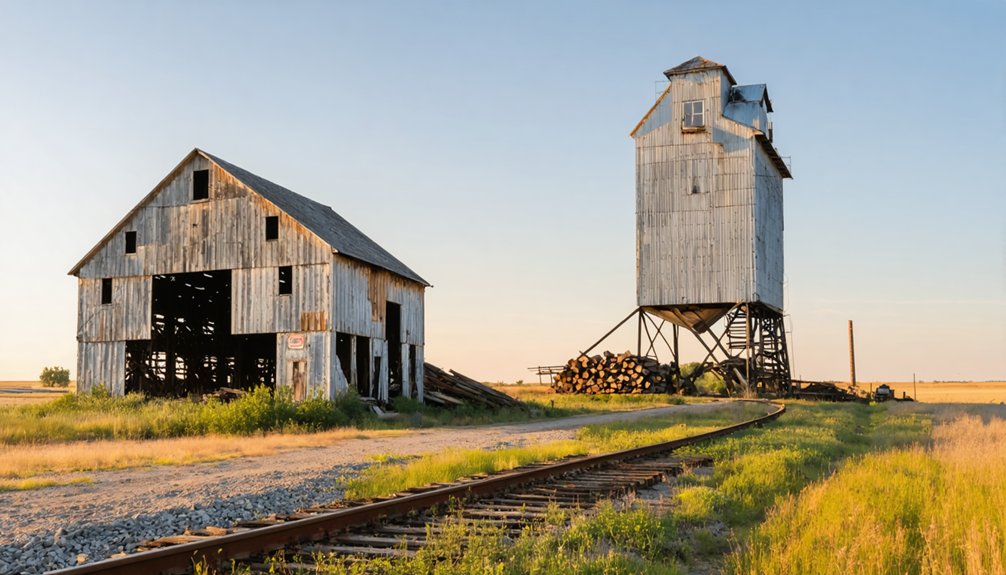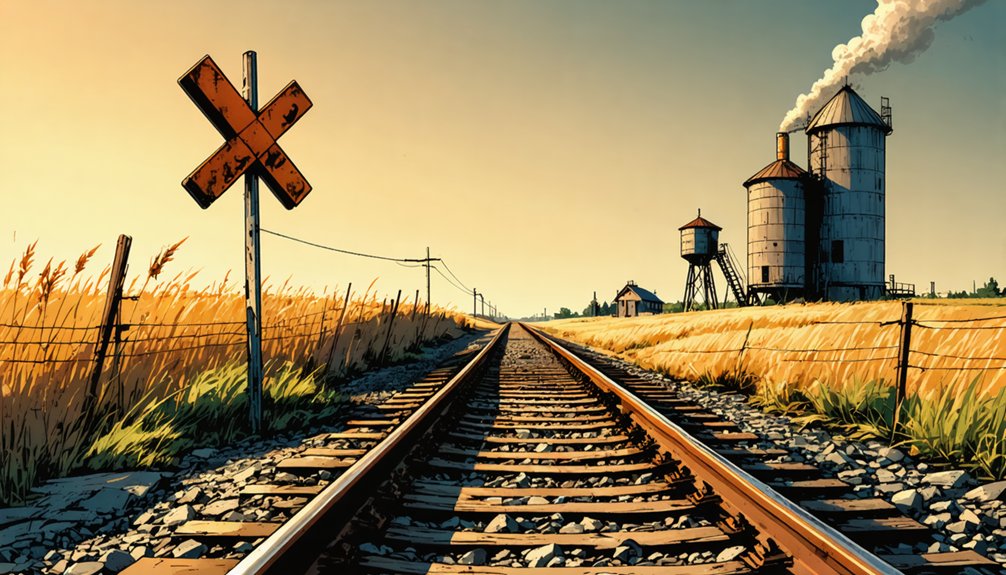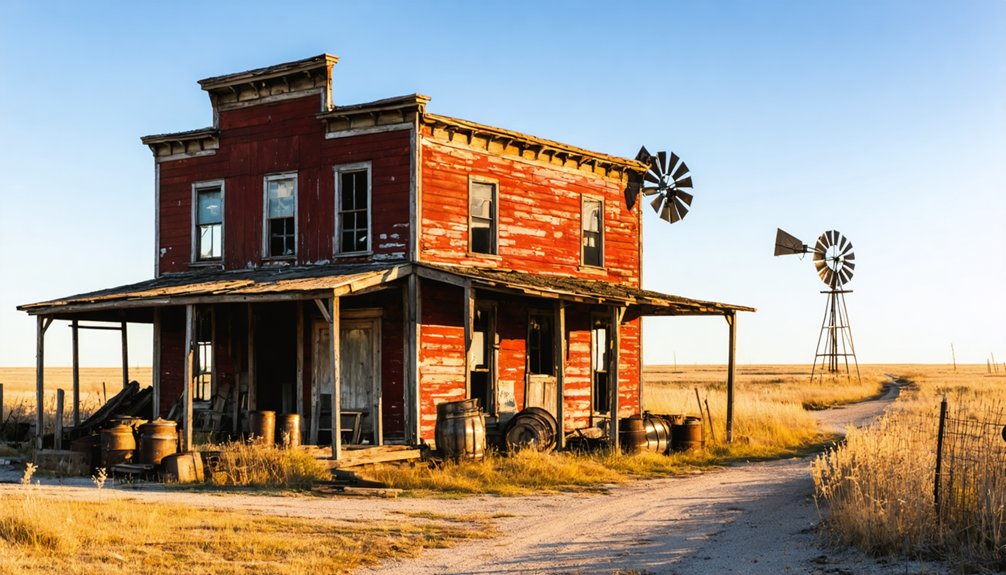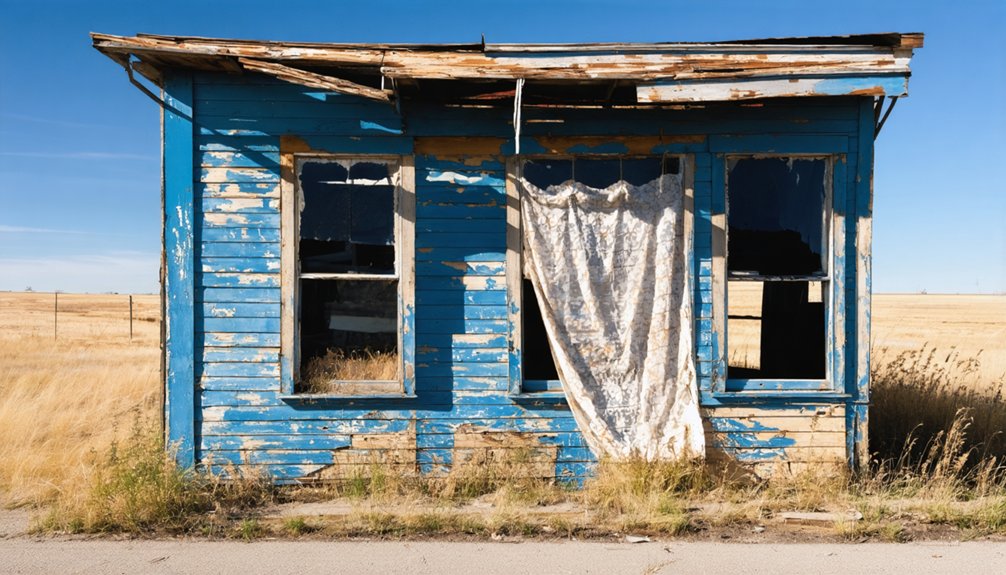You’ll find the ghost town of Brennan nestled in South Dakota’s Black Hills, where pioneer John R. Brennan established a crucial gold rush settlement in 1875. His vision transformed a simple prospector’s camp into a bustling hub with hotels, a post office, and essential rail connections. Though the town thrived on mining, logging, and railroad industries, economic struggles by the mid-20th century led to its abandonment. The town’s rich history lives on through preserved documents and photographs at the South Dakota Historical Resource Center.
Key Takeaways
- Brennan was established in 1876 as a mining settlement during the Black Hills gold rush, founded by pioneer John R. Brennan.
- The town’s economy relied heavily on mining, logging, and railroad operations, making it vulnerable to industry-specific downturns.
- Economic decline began mid-20th century, with the 1952 sawmill closure triggering significant population loss and community deterioration.
- Limited economic diversification and harsh weather conditions contributed to the settlement’s eventual abandonment and ghost town status.
- Historical records of Brennan are preserved at the South Dakota Historical Resource Center through documents, photographs, and correspondence.
The Rise of a Black Hills Mining Settlement
As the first waves of prospectors descended upon the Black Hills in 1875, they discovered promising placer deposits near French Creek and Whitewood Creek that would forever change the region’s destiny.
These early miners encountered several Native American tribes including the Kiowa and Crow who had long inhabited the region.
You’d have found these early mining settlements teeming with ambitious prospectors seeking their fortunes, sifting through streams for loose gold while dreaming of striking the Mother Lode.
The gold discovery that truly transformed the region came in 1876 with the Homestake claim near present-day Lead.
The Homestake discovery in 1876 marked a turning point, transforming the Black Hills from prospecting grounds into a major mining center.
When George Hearst invested $70,000 to purchase it in 1877, the era of industrial mining began.
The Homestake Mine became one of the most productive gold mines in history, producing 10% of global gold for over a century.
While many small claims dotted the creeks, the real action centered around Lead and Deadwood, where hard-rock mining operations replaced the dwindling placer deposits by 1880.
John R. Brennan’s Pioneer Legacy
You’ll find John R. Brennan’s pioneering spirit through his detailed diary entries chronicling the dangerous 1875 westward expedition to the Black Hills.
As one of Rapid City’s founding fathers in 1876, Brennan helped transform the “Hay Camp” settlement into a thriving gateway to the mining region while serving as the town’s first postmaster and establishing essential transportation routes.
Brennan established the first hotel, a modest 12×14 log cabin that would become a cornerstone of the developing community.
He later expanded his hospitality business by constructing the prestigious Harney Hotel, which became a landmark establishment in the growing town.
Brennan’s preserved family papers and personal accounts offer a rare glimpse into the challenges and triumphs of early Black Hills settlement, documenting the region’s transformation from frontier outpost to established community.
Early Black Hills Expeditions
While Native American tribes fiercely defended their territories in the 1870s, John R. Brennan joined the wave of adventurous settlers pushing into the Black Hills.
You’ll find his story intertwined with early exploration during a time when government restrictions and violent encounters made settlement incredibly dangerous. After the Custer Expedition’s 1874 gold discovery, Brennan and other young pioneers, including Civil War veterans, braved the hostile conditions to establish lasting communities. Along with several other pioneers, he helped establish Hay Camp settlement, which would later become Rapid City.
Before 1877, you’d have encountered early settlements like Spearfish, Bear Gulch, Custer, and Hill City springing up across the region.
The men who ventured in risked their lives, driven by dreams of gold placers and the promise of new beginnings. These initial settlements marked the beginning of a dramatic transformation in Black Hills history.
Rapid City’s Founding Father
Pioneer spirit and determination drove John R. Brennan to lay the foundation of what you know today as Rapid City. After his gold prospecting dreams faded, Brennan’s leadership transformed a humble “Hay Camp” into a thriving community on February 25, 1876.
You’ll find his innovative urban planning reflected in the square-mile business district he established alongside Samuel Scott. He expertly surveyed the city’s layout using a pocket compass and tape.
As Rapid City’s first postmaster, council president, and mayor, Brennan shaped the city’s early governance. His business acumen brought modern amenities through ventures like the American House and the prestigious Harney Hotel.
Born in Ireland but drawn to the American frontier, Brennan’s vision carried Rapid City from a prospector’s camp to an essential Black Hills hub, leaving a legacy that continues to inspire freedom-seeking pioneers.
Preserving Frontier History Records
Thanks to meticulous preservation efforts at the South Dakota Historical Resource Center, the John R. Brennan Family Papers provide you with an authentic window into frontier life.
Through careful archival preservation, you’ll discover firsthand accounts of Rapid City’s founding in 1876, from Brennan’s initial arrival to his final days in 1919.
The historical documentation includes personal letters, official records, and photographs that tell the story of a pioneering spirit.
You’ll find detailed accounts of Brennan’s roles as postmaster, city council president, and Pine Ridge Indian Reservation superintendent.
His journals reveal daily challenges of frontier settlement, while maps and photographs showcase early town development. Like Valentine McGillycuddy, he was deeply involved in Pine Ridge Reservation affairs.
These preserved materials serve as crucial primary sources for understanding the remarkable transformation of western South Dakota from wilderness to civilization.
Life in a Frontier Mining Community
You’d have faced grueling physical demands in Brennan’s early mining days, from the backbreaking work of placer mining to the constant dangers of underground tunnels.
The harsh realities of frontier life brought settlers together, as they relied on each other for survival through the establishment of essential community services like fire departments and supply networks. Like hundreds of other communities across the Black Hills region, Brennan became one of the abandoned mining towns that dotted the landscape. The discovery of gold in 1874 sparked a rush of prospectors seeking fortune in the Black Hills region.
Through John Brennan’s leadership roles as postmaster and city council president, you’d have witnessed how a discouraged prospector’s camp transformed into an organized community bound by shared hardships and determination.
Daily Challenges Underground
Life in Brennan’s underground mines tested the limits of human endurance, as miners faced a relentless barrage of physical and environmental challenges.
You’d spend long hours in dimly lit shafts, where the constant threat of cave-ins and falling rocks made every moment underground a gamble with fate. The air you breathed was thick with dust, slowly destroying your lungs as primitive ventilation systems failed to clear the hazardous particles.
Your daily routine involved backbreaking manual labor with basic hand tools, hauling heavy ore through narrow passages.
Underground hazards lurked everywhere – unstable support beams, toxic gases, and the ever-present risk of explosives accidents. The toll on miners’ health was severe, yet medical care remained minimal, and you’d often work through injuries and illness, knowing that every day underground meant another chance to strike it rich.
Community Bonds Through Hardship
Despite the grueling conditions underground, Brennan’s residents forged powerful bonds through shared adversity and mutual support. You’d find neighbors readily pooling resources when mining accidents struck, ensuring affected families had food and care.
Community resilience showed in how residents organized their own emergency services and postal systems, while shared cultural celebrations strengthened their collective spirit.
When disputes arose between mining companies and townsfolk over land rights, you’d see the community’s strength in action. Through careful negotiation and compromise, they’d find ways to protect both corporate interests and residents’ needs.
The harsh frontier environment demanded mutual aid – whether fighting fires, weathering storms, or defending against external threats. These daily challenges transformed Brennan from a mere mining camp into a tight-knit community bound by shared purpose.
Economic Foundations and Industries

Three core industries formed the economic backbone of Brennan during its heyday: mining, railroads, and logging.
Mining prosperity defined the town’s identity in the Black Hills region, where gold and silver deposits attracted fortune-seekers to establish roots. You’d find rail lines threading through the rugged landscape, connecting Brennan to larger markets and enabling the transport of precious ore, timber, and essential supplies.
The railroad’s impact extended beyond mere transportation – it sparked the growth of supporting businesses like flour mills, banks, and general stores. Like many South Dakota towns, it was established every seven miles to service steam locomotives.
Meanwhile, the region’s logging operations supplied vital timber for mine construction and railroad ties. You can still trace the remnants of these interconnected industries through abandoned rail grades and weathered structures that tell the story of Brennan’s bustling past.
Daily Challenges of the Gold Rush Era
While fortune-seekers flocked to Brennan’s promising goldfields, they soon faced brutal living conditions that tested their resilience daily.
You’d have found yourself struggling against overcrowded camps where poor goldfield sanitation led to contaminated water and deadly disease outbreaks. Your makeshift tent or shack would’ve offered little protection from harsh weather, while scarce food supplies commanded astronomical prices.
The constant threat of mining injuries loomed large, with unguarded shafts, burns, and equipment accidents claiming lives regularly. Without proper medical care, even minor wounds could turn fatal.
You’d have witnessed vigilante justice replacing law and order, as theft and violence became commonplace. Native Americans and immigrant miners faced particularly harsh treatment, often subjected to discrimination and violent displacement in the scramble for gold.
Transportation and Railroad Connections

The Black Hills’ rugged terrain posed unique challenges for connecting mining settlements like Brennan to the wider world, yet ingenious railroad developments soon transformed the region’s isolation.
Transportation networks expanded rapidly, following mining ventures and timber operations into remote areas, where specialized locomotives tackled grades as steep as 34%.
- You’d find Shay and Heisler engines conquering the challenging landscape, hauling precious cargo along narrow-gauge tracks.
- Railroad stops became the lifeblood of new communities, bringing essential supplies and connecting isolated towns.
- Rail crews established temporary settlements like Castleton, which later became ghost towns as operations moved on.
- These crucial transportation networks didn’t just move ore and timber – they brought post offices, schools, and the promise of prosperity to frontier communities.
The Path to Abandonment
Like many Black Hills settlements, Brennan’s path to abandonment began with a perfect storm of economic struggles and industry failures in the mid-20th century.
When the sawmill closed in 1952, you would’ve witnessed the first major wave of outmigration patterns as families sought work elsewhere. The town’s lack of economic diversification meant it couldn’t recover from the loss of mining and timber industries.
Nature didn’t help either – floods damaged homes while harsh weather made agriculture difficult.
You’d have seen services disappearing one by one: the railroad ceased operations, the post office closed, and schools shut their doors.
As young residents fled to urban centers, Brennan’s remaining population aged without replacement.
The town’s social fabric unraveled as churches and gathering places emptied, leaving only memories of a once-thriving community.
Preserving Brennan’s Historical Heritage

Despite Brennan’s ghostly silence today, you’ll find its rich history meticulously preserved through the John R. Brennan family papers at the South Dakota Historical Resource Center.
These invaluable documents provide a window into the town’s past through historical documentation that captures life on Pine Ridge Reservation.
You can explore Brennan’s heritage through:
- Three volumes of authentic photographs depicting daily reservation life
- Personal and official correspondence revealing local governance
- Scrapbooks documenting diverse aspects of early 20th century conflicts
- Legal records and estate documents showcasing administrative challenges
While physical preservation poses ongoing challenges, efforts to increase archival accessibility through digitization could help you connect with this fascinating chapter of South Dakota’s past, ensuring Brennan’s story lives on for future generations.
Frequently Asked Questions
Are There Any Remaining Structures or Ruins Visible at Brennan Today?
You won’t find any standing remaining buildings at this site today, though scattered historical artifacts and building foundations might still be visible beneath overgrown vegetation and weathered terrain.
What Native American Tribes Originally Inhabited the Area Around Brennan?
You’ll find that Sioux tribes, particularly the Yankton and Yanktonai Dakota bands, originally called this land home, while Lakota heritage also runs deep through the surrounding prairie grasslands.
Did Any Famous Outlaws or Notable Personalities Visit Brennan?
While you won’t find records of famous outlaw encounters in Brennan, the only notable visitor documented was John R. Brennan himself during his 1875 Black Hills expedition that helped establish the settlement.
What Happened to the Residents After Brennan Was Abandoned?
You’ll find that most residents moved to Rapid City and Deadwood seeking new opportunities after economic decline hit. They shifted into railroad jobs, mining work, and commerce while adapting to life beyond Brennan.
Were There Any Major Epidemics or Natural Disasters in Brennan’s History?
You’ll find no major recorded natural disasters in Brennan itself, though nearby towns faced influenza outbreaks in 1918-1919. The region’s harsh winters and mining-related environmental challenges affected daily life.
References
- https://www.sdpb.org/arts-life/vanished-south-dakota-in-the-moment
- https://www.youtube.com/watch?v=Glucs_Rq8Xs
- https://history.sd.gov/archives/docs/Brennan.pdf
- https://www.youtube.com/watch?v=_0WNYsFLSLA
- https://www.powderhouselodge.com/black-hills-attractions/fun-attractions/ghost-towns-of-western-south-dakota/
- https://www.sdhspress.com/journal/south-dakota-history-14-1/dakota-resources-the-john-r-brennan-family-papers-at-the-south-dakota-historical-resource-center/vol-14-no-1-dakota-resources.pdf
- https://en.wikipedia.org/wiki/List_of_ghost_towns_in_South_Dakota
- https://www.youtube.com/watch?v=GQH5mp2emBw
- https://icatchshadows.com/okaton-and-cottonwood-a-photographic-visit-to-two-south-dakota-ghost-towns/
- https://blackhillsvisitor.com/learn/spokane/



